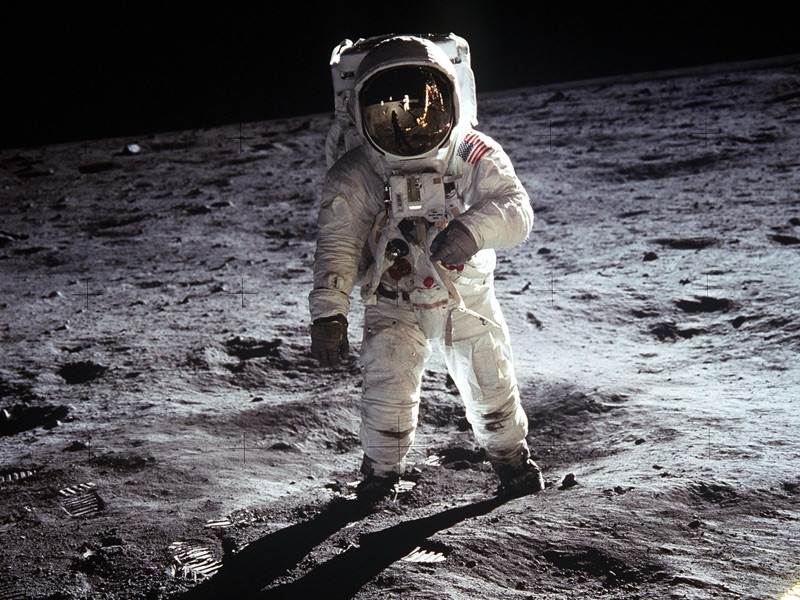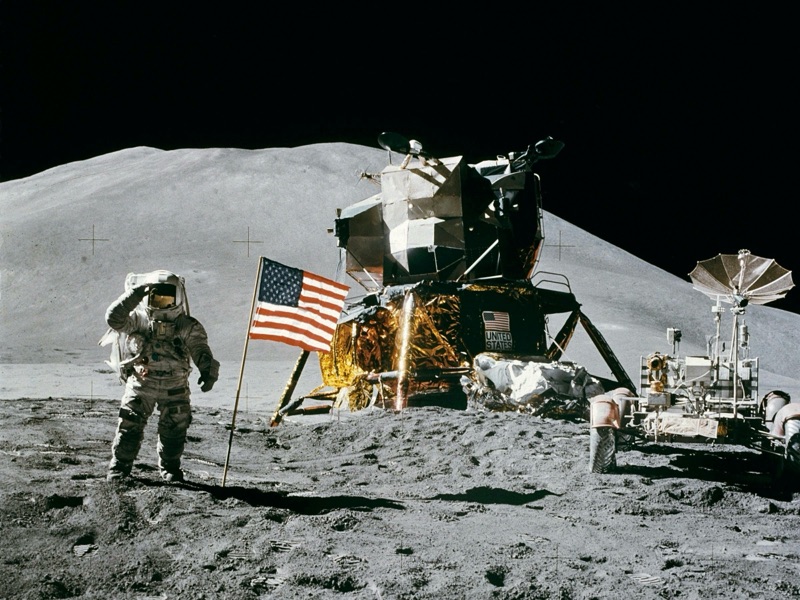For thousands of years, the Moon was a distant, mysterious companion to Earth—shaping tides, marking time, and inspiring countless stories and legends. But since 1969, it has also become a silent witness to humanity’s boldest explorations. Though lifeless and untouched by weather, the lunar surface holds a remarkable collection of artifacts left behind by astronauts, rovers, and robotic landers. These objects are not just space debris—they are evidence of human ambition, scientific progress, and a shared global legacy.
In this post, we’ll explore the objects left on the Moon over the decades—how they got there, what purposes they served, and what they represent as humanity prepares to return for a new era of lunar exploration.

The Apollo Era (1969–1972)
NASA’s Apollo program, launched in the heat of the Cold War space race, marked the first—and so far only—time humans have walked on the Moon. Six missions landed astronauts on the lunar surface between 1969 and 1972: Apollo 11, 12, 14, 15, 16, and 17.
Key Objects Left Behind:
Lunar Module Descent Stages
Each landing mission’s Lunar Module consisted of two parts: an ascent stage (which returned to orbit) and a descent stage (which remains on the Moon). These lower halves, some weighing over 10,000 pounds, still sit where they were left.
Scientific Instruments (ALSEPs)
Apollo 12 through 17 deployed packages of scientific equipment known as Apollo Lunar Surface Experiments Packages (ALSEPs). These included seismometers, magnetometers, and heat flow probes, designed to operate long after the astronauts departed.
Lunar Roving Vehicles
Apollo 15, 16, and 17 carried battery-powered “Moon buggies” that greatly expanded the range of exploration. These rovers remain parked at their landing sites.
Retroreflectors
Apollo 11, 14, and 15 left behind laser retroreflectors that are still used today to measure the Earth-Moon distance with millimeter precision.
Personal and Symbolic Items
Among the more poetic artifacts left behind:
- The “Fallen Astronaut” aluminum sculpture and plaque honoring deceased astronauts and cosmonauts (Apollo 15)
- A gold olive branch, symbolizing peace (Apollo 11)
- Family photos, mission patches, U.S. flags, and handwritten messages
NASA estimates that more than 180 tons of equipment, tools, and refuse were left behind by the Apollo missions alone.

The Soviet Robotic Legacy (1959–1976)
While the U.S. put humans on the Moon, the Soviet Union made numerous pioneering robotic lunar missions under the Luna program.
Highlights:
Luna 2 (1959)
The first human-made object to reach the Moon, Luna 2 impacted the surface and scattered commemorative Soviet pennants.
Luna 9 (1966)
The first spacecraft to achieve a soft landing on the Moon, it transmitted photos from the surface.
Lunokhod 1 and 2 (1970 & 1973)
These remote-controlled rovers traveled many kilometers on the Moon, conducting experiments and taking thousands of images. Lunokhod 1’s retroreflector was rediscovered and is still functional.
Luna 16, 20, 24 (1970s)
These missions collected lunar samples robotically and returned them to Earth, leaving behind ascent stages and landers.
A New Wave of Exploration (2000s–2025)
After a long pause, the 21st century has seen renewed interest in the Moon—driven by scientific, commercial, and geopolitical motivations. Countries including China, India, and the United States have returned, and private companies have joined the race.
China’s Chang’e Program:
Chang’e 3 (2013)
The first Chinese Moon landing. Its lander and the Yutu rover remain on the surface in the Mare Imbrium.
Chang’e 4 (2019–Present)
The first spacecraft to land on the Moon’s far side. It deployed the Yutu-2 rover, which continues to operate after more than six years.
Chang’e 5 (2020)
Collected and returned about 1.7 kg of lunar samples. The mission left behind the lander and ascent stage.
Chang’e 6 (Launched May 2024, Returned June 2024)
Collected the first-ever samples from the Moon’s far side. The lander and equipment remain on the lunar surface.
India’s Chandrayaan Program:
Chandrayaan-3 (2023)
After a failed 2019 attempt, India successfully landed near the Moon’s south pole. The lander (Vikram) and rover (Pragyan) explored the surface for about two weeks and remain where they stopped transmitting.

U.S. Commercial and Government Missions:
Intuitive Machines’ Odysseus Lander (IM-1, February 2024)
The first U.S. lunar landing since 1972 and the first private lander to succeed. Odysseus carried NASA instruments and now rests on its side near the lunar south pole.
Astrobotic’s Peregrine Mission (January 2024)
Failed to reach the Moon due to a propulsion system leak, but still marked a milestone in lunar mission development. Its payload burned up on reentry.
NASA’s Artemis Program (2022–Present)
While Artemis 1 (2022) was an uncrewed test flight around the Moon, Artemis 2 (now scheduled for 2026) will be the first crewed flight in over 50 years. Artemis 3, targeted for 2027, aims to land astronauts at the Moon’s south pole.
A Strange and Silent Museum
The Moon holds more than 100 spacecraft components, tools, and personal items left behind by humans and robots alike. Among the odder objects:
- A feather and hammer used in Apollo 15’s gravity experiment
- Lunar boots discarded to save weight
- Human waste containers
- Empty food packages and used scientific gear
- Dozens of national flags planted by various missions
The lunar surface is effectively an open-air museum, untouched by wind or water, preserving each item indefinitely unless future missions interfere.

Looking Ahead: A New Lunar Chapter (2025 and Beyond)
As of mid-2025, a new era of lunar exploration is fully underway. The next five years are expected to bring even more missions to the Moon, with goals that go far beyond symbolic landings.
What’s Next?
- Artemis 2 (2026): First crewed mission around the Moon since Apollo 17.
- Artemis 3 (2027): Planned crewed landing at the Moon’s south pole, in partnership with SpaceX’s Starship Human Landing System.
- Lunar Gateway (Construction Begins Late 2020s): A small orbital space station to support long-term lunar exploration.
- More CLPS Missions (Commercial Lunar Payload Services): NASA-funded landers by private companies to deliver instruments and cargo to the surface.
- International Partnerships: Japan, the UAE, and the European Space Agency are contributing to upcoming lunar missions and technologies.
These missions aim not just to explore but to establish long-term infrastructure—habitats, power systems, and communication networks—that may one day support permanent lunar operations.
Conclusion: The Moon as Our Mirror
The objects we’ve left on the Moon are more than hardware. They’re milestones in the human story—evidence of curiosity, courage, and our desire to reach beyond. The Moon has become a mirror, reflecting both our past achievements and our future ambitions.
As we move into a new era of lunar exploration, we do so with the weight of history underfoot. The Moon’s surface is etched with our legacy—and soon, it may hold the foundations of a future civilization in space.
Sources and Further Reading
- NASA Lunar Missions: nasa.gov/moon
- Chang’e Missions – CNSA: cnsa.gov.cn
- ISRO Chandrayaan Updates: isro.gov.in
- “List of Artificial Objects on the Moon” – Wikipedia: en.wikipedia.org
- Artemis Program Overview – NASA: nasa.gov/specials/artemis
- Intuitive Machines and Astrobotic: intuitivemachines.com | astrobotic.com